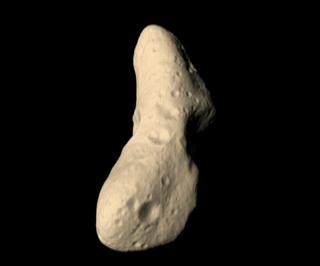Portrait Of An Asteroid

Scientists use lasers to create a 3-D model of asteroid Eros.
Not all asteroids look the same. In fact, the appearance of an asteroid can vary depending on factors like its age, composition and how it evolved. In 2000, after a four-year journey from Earth, NASA’s NEAR Shoemaker spacecraft began circling Eros, the second-largest near-Earth asteroid. Researchers believe that Eros is a pristine leftover from when the solar system formed 4.6 billion years ago. To learn more about Eros, a laser rangefinder instrument aboard the spacecraft pinged the 20-mile-long chunk of rock with approximately 8 million infrared pulses over the course of a year. The light-based measurements yielded information about the height and shape of features on the asteroid’s surface, allowing scientists to construct a detailed 3-D model of its topography. The model helped scientists study the asteroid’s many craters and offered insights into its internal structure. Watch the video for a tour of Eros.
This model of Eros was created using millions of data points collected by NASA’s NEAR Shoemaker spacecraft while in orbit around the asteroid.

Eros is pitted with over 100,000 craters, the result of billions of years of impacts.

The large crater at the center, named Psyche, is three miles in diameter.

Eros' largest crater, Himeros (top), is six miles in diameter. It’s so big that its sides caved in, leaving behind a saddle-shaped depression.
Credits
Please give credit for this item to:
NASA's Scientific Visualization Studio
-
Writer
- Kerry Klein (USRA)
-
Scientists
- Andrew Cheng (Johns Hopkins University/APL)
- David Smith (NASA/GSFC)
- Maria Zuber (Massachusetts Institute of Technology)
-
Animators
-
Greg Shirah
(NASA/GSFC)
- Tom Bridgman (Global Science and Technology, Inc.)
- Marte Newcombe (Global Science and Technology, Inc.)
-
Greg Shirah
(NASA/GSFC)
Release date
This page was originally published on Tuesday, April 7, 2015.
This page was last updated on Wednesday, May 3, 2023 at 1:49 PM EDT.
